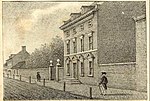Christ Church Burial Ground

Christ Church Burial Ground in Philadelphia is an important early-American cemetery. It is the final resting place of Benjamin Franklin and his wife, Deborah. Four other signers of the Declaration of Independence are buried here, Benjamin Rush, Francis Hopkinson, Joseph Hewes and George Ross. Two more signers (James Wilson and Robert Morris) are buried at Christ Church just a few blocks away. The cemetery belongs to Christ Church, the Episcopal church founded in 1695 and place of worship for many of the famous Revolutionary War participants, including George Washington. The burial ground is located at 5th and Arch Streets, across from the Visitors Center and National Constitution Center. The Burial Ground was started in 1719, and it is still an active cemetery. The Burial Ground is open to the public for a small fee, weather permitting; about 100,000 tourists visit each year. When the Burial Ground is closed, one can still view Benjamin Franklin's gravesite from the sidewalk at the corner of 5th and Arch through a set of iron rails. The bronze rails in the brick wall were added for public viewing in 1858 by parties working at the behest of the Franklin Institute, which assumed the responsibility of defending Franklin's historic ties to Philadelphia after prominent Bostonians criticized the city's maintenance of the grave and erected a Franklin statue there. Leaving pennies on Franklin's grave is an old Philadelphia tradition.
Excerpt from the Wikipedia article Christ Church Burial Ground (License: CC BY-SA 3.0, Authors, Images).Christ Church Burial Ground
5th Street, Philadelphia Center City
Geographical coordinates (GPS) Address Nearby Places Show on map
Geographical coordinates (GPS)
| Latitude | Longitude |
|---|---|
| N 39.951944444444 ° | E -75.148611111111 ° |
Address
Commodore Uriah P. Levy
5th Street
19106 Philadelphia, Center City
Pennsylvania, United States
Open on Google Maps








